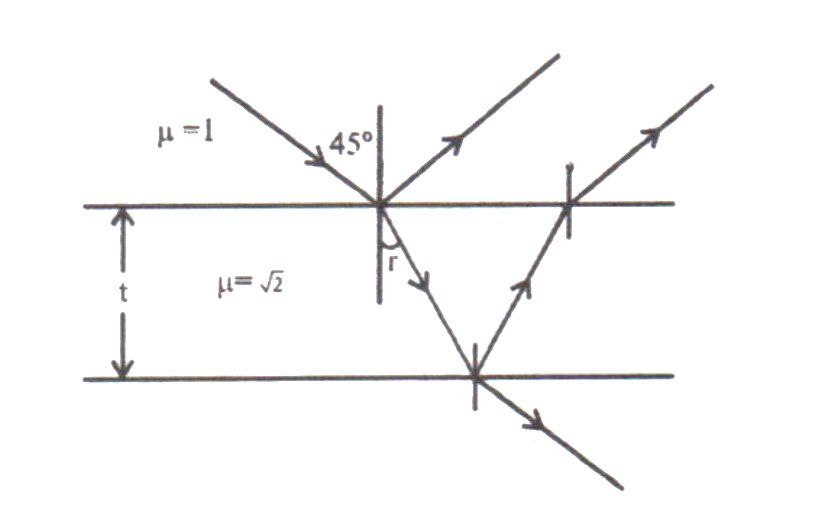What is the minimum thickness of a soap bubble needed for constructive interference in reflected light, if the light incident on the film is 750 nm? Assume that the refractive index for the film is n=1.33
282 nm
70.5 nm
141 nm
387 nm
The correct Answer is:C
To find the minimum thickness of a soap bubble needed for constructive interference in reflected light, we can follow these steps:
Step 1: Understand the Condition for Constructive Interference
For constructive interference in a thin film, the condition is given by:
2T=mλ′+λ′2
where:
- T is the thickness of the film,
- m is the order of interference (an integer),
- λ′ is the wavelength of light in the medium.
Step 2: Calculate the Wavelength in the Medium
The wavelength of light in the medium can be calculated using the formula:
λ′=λn
where:
- λ is the wavelength of light in vacuum (750 nm),
- n is the refractive index of the medium (1.33).
Substituting the values:
λ′=750nm1.33
Step 3: Substitute m for Minimum Thickness
For minimum thickness, we take m=0:
2T=0⋅λ′+λ′2
This simplifies to:
2T=λ′2
Step 4: Solve for Thickness T
Rearranging the equation gives:
T=λ′4
Step 5: Substitute λ′ into the Thickness Formula
Now we can substitute λ′ into the thickness formula:
T=14(750nm1.33)
Step 6: Calculate the Numerical Value
Calculating λ′:
λ′=750×10−9m1.33≈563.91×10−9m
Now substituting this into the thickness formula:
T=563.91×10−94≈140.98×10−9m
or approximately:
T≈141nm
Final Answer
The minimum thickness of the soap bubble needed for constructive interference in reflected light is approximately 141 nm.
---
For constructive interference in a thin film, the condition is given by:
2T=mλ′+λ′2
where:
- T is the thickness of the film,
- m is the order of interference (an integer),
- λ′ is the wavelength of light in the medium.
The wavelength of light in the medium can be calculated using the formula:
λ′=λn
where:
- λ is the wavelength of light in vacuum (750 nm),
- n is the refractive index of the medium (1.33).
λ′=750nm1.33
For minimum thickness, we take m=0:
2T=0⋅λ′+λ′2
This simplifies to:
2T=λ′2
Rearranging the equation gives:
T=λ′4
Now we can substitute λ′ into the thickness formula:
T=14(750nm1.33)
Calculating λ′:
λ′=750×10−9m1.33≈563.91×10−9m
T=563.91×10−94≈140.98×10−9m
or approximately:
T≈141nm
The minimum thickness of the soap bubble needed for constructive interference in reflected light is approximately 141 nm.
Topper's Solved these Questions
- BOOK - NCERT FINGERTPS ENGLISHCHAPTER - WAVE OPTICSEXERCISE - HIGHER ORDER THINKING SKILLS8videos
WAVE OPTICS
- BOOK - NCERT FINGERTPS ENGLISHCHAPTER - WAVE OPTICSEXERCISE - NCERT EXEMPLAR PROBLEMS5videos
WAVE OPTICS
- BOOK - NCERT FINGERTPS ENGLISHCHAPTER - SEMICONDUCTOR ELECTRONICS : MATERIALS , DEVICES AND SIMPLE CIRCUITS EXERCISE - Assertion And Reason15videos
SEMICONDUCTOR ELECTRONICS : MATERIALS , DEVICES AND SIMPLE CIRCUITS
Similar Questions
What is the minimum thickness of thin film required for constructive interference in the reflected light through it ?
(Given, the refractive index of the film =1.5, wavelength of the lilght incident on the film =600 nm.View SolutionCalculate the minimum thickness of a soap bubble film (μ=1.33)that results in constructive interference in the reflected light if the film is illuminated with light whose wavelength in free space is λ=600nm.
View SolutionCan reflection result in plane polarised light if the light is incident on interface from the side with higher refractive index?
View SolutionWhat is the minimum thickness of a thin film (μ=1.2) that results in constructive interference in the reflected light? If the film is illuminated with light whose wavelength in free space is λ=500nm ?
View SolutionAn oil film covers the surface of a small pond. The refractive index of the oil is greater than that of water. At one point on the film, the film has the smallest non-zero thickness for which there will be destructive interference in the reflected light when infrared radiation with wavelength 800 nm is incident normal to the film. When this film is viewed at normal incidence at this same point, for what visible wavelengths, if any, will there be constructive interference? (Visible light has wavelengths between 400nm and 700 nm )
View SolutionApproximate thickness of oil film to observe interference of light (due to which it looks coloured) is
View SolutionThe angle of incidence at which reflected light is totally polarized for reflection from air to glass (refractive index n),
View SolutionThe angle of incidence at which reflected light is totally polarised for reflection from air to glass (refractive index n) is
View SolutionA ray of light is incident at an angle of 45∘ (ralative to the normal) on a thin film of a liquid with an index of refraction of √2. Assuming that the medium of both sides of the film is air, find the minimum thickness of the film required for constructive interference in the reflected light for sodium light of wavelenght 600 nm.
 View Solution
View SolutionRefractive index of a thin soap film of a uniform thickness is 1.38. The smallest thickness of the film that gives an interference maxima in the reflected light when light of wavelength 5520 Å falls at normal incidence is
View Solution

